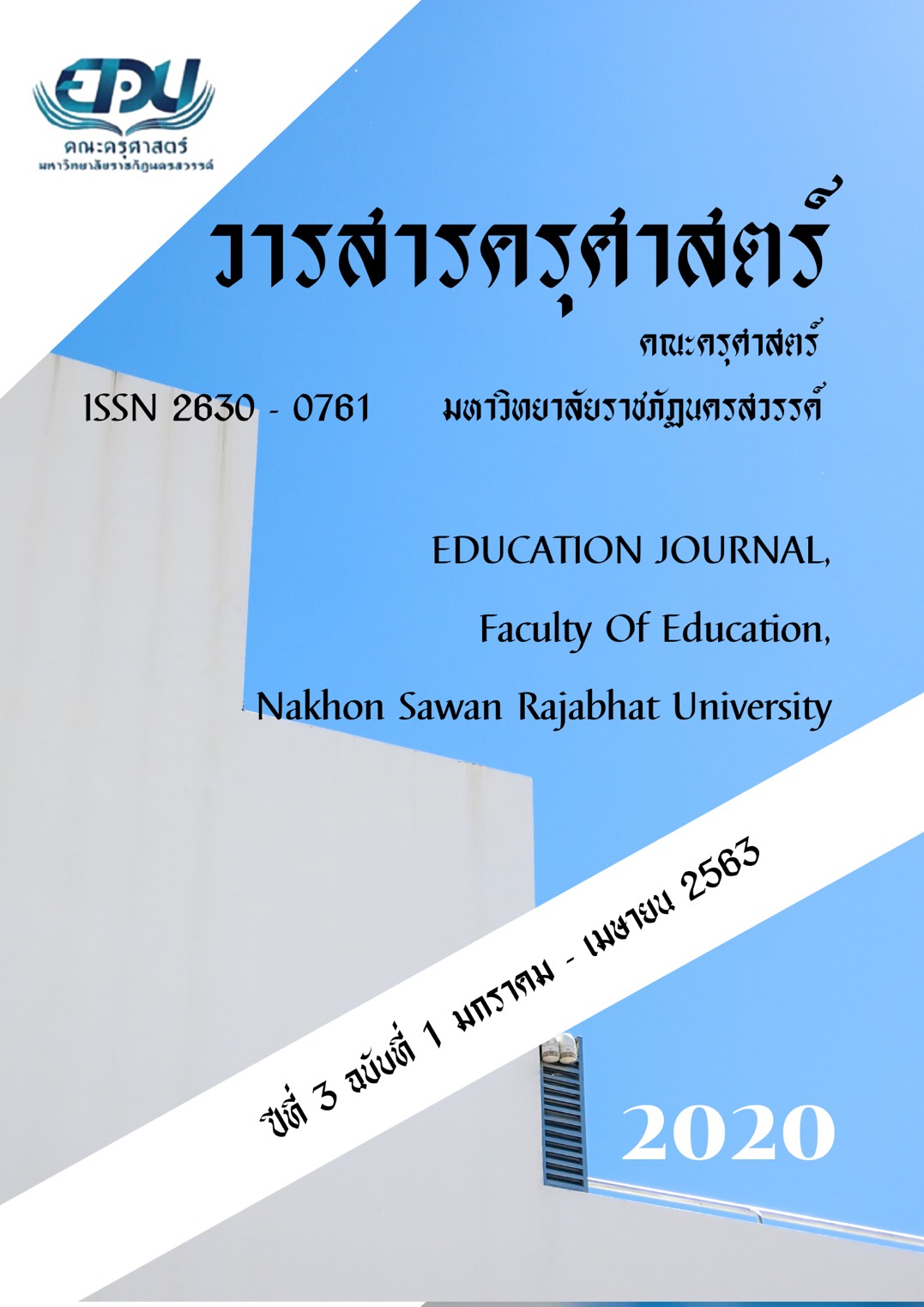The Development of Learning Achievement in The Development of Southeast Asia of Mathayomsuksa 1 Students by Using Cooperative Learning Management Using STAD Technique
Main Article Content
Abstract
The purposes of this research were to 1) To compare the of learning achievement of mathayomsuksa 1 students before and after receiving cooperative learning through STAD technique and 2) To compare the learning achievement of mathayomsuksa 1 students who received cooperative learning management using STAD technique with 60% criterion. The sample group consisted of mathayomsuksa 1 students at 1/1 of Thetsaban Wat Woranat Banphot school Mueang Nakhon Sawan district Nakhon Sawan province under Nakhon Sawan municipality, region 1, term 2, academic year 2019, amount 30 people, were obtained by simple random sampling using the classroom as a random unit. The tools used in this research consisted of 1) learning management plan with a collaborative model with STAD technique 2) Achievement test before and after learning. Data analysis were mean, standard deviation and t-test. The results were as follows:
1) Mathayomsuksa 1 students receiving cooperative learning management using STAD technique have higher academic achievement after studying statistical significance at the level of .05. and 2) Mathayomsuksa 1 students receiving cooperative learning management using STAD technique have academic achievement above the threshold of 60 percent with statistical significance at the level of .05.
Downloads
Article Details

This work is licensed under a Creative Commons Attribution-NonCommercial-NoDerivatives 4.0 International License.
References
กระทรวงศึกษาธิการ. (2553). หลักสูตรการศึกษาขั้นพื้นฐาน พุทธศักราช 2553. กรุงเทพฯ: ชุมนุมสหกรณ์การเกษตรแห่งประเทศไทย.
ชัยวัฒน์ สุทธิรัตน์. (2552). 80 นวัตกรรมการจัดการเรียนรู้ที่เน้นผู้เรียนเป็นสำคัญ. กรุงเทพฯ: แดเน็ทซ์ อินเตอร์ คอร์ปอเรชั่น.
นฤมล นาดสูงเนิน. (2552). การพัฒนาแผนการจัดกิจกรรมการเรียนรู้ วิชา การบัญชีเบื้องต้น 1 เรื่องสินทรัพย์ หนี้สินส่วนของเจ้าของ (ทุน) ระดับประกาศนียบัตรวิชาชีพปีที่ 1 โดยใช้รูปแบบการเรียนรู้แบบกลุ่มร่วมมือ (STAD).
รายงานวิจัย. มหาวิทยาลัยมหาสารคาม.
ทิศนา แขมมณี. (2553). ศาสตร์การสอน: องค์ความรู้เพื่อการจัดกระบวนการเรียนรู้ที่มีประสิทธิภาพ. (พิมพ์ครั้งที่ 13). กรุงเทพฯ: สำนักพิมพ์แห่งจุฬาลงกรณ์มหาวิทยาลัย.
สมสวาท โพธิ์กฎ. (2552). ผลการจัดกิจกรรมการเรียนรู้ด้วยกลุ่มร่วมมือแบบ STAD กลุ่มสาระการเรียนรู้ศิลปะ ชั้นมัธยมศึกษาปีที่2. วิทยานิพนธ์การศึกษามหาบัณฑิต (หลักสูตรและการสอน). มหาวิทยาลัยมหาสารคาม.
อดิศร ศักดิ์สูง. (2552). ครูสังคมศึกษากับประวัติศาสตร์ เทคนิคการสอนและการทำผลงานทางวิชาการ. สงขลา:มหาวิทยาลัยทักษิณ.
อทิติยา สวยรูป. (2556).ผลสัมฤทธิ์ทางการเรียนจากการเรียนแบบกลุ่มร่วมมือ (Cooperative Learning) โดยใช้เทคนิค Student Team Achievement Division (STAD) รายวิชาเทคโนโลยีสารสนเทศ เรื่อง คอมพิวเตอร์เบื้องต้น ของนักเรียนมัธยมศึกษาปีที่ 1 ด้วยการเรียนการสอนด้วยวิธีแบบกลุ่มร่วมมือโดยใช้เทคนิค STAD. รายงานวิจัย. มหาวิทยาลัยเกษตรศาสตร์ วิทยาเขตบางเขน.
อิทธิพล เจริญเมือง. (2554). การพัฒนาบทเรียนคอมพิวเตอร์ช่วยสอนบนระบบเครือข่ายด้วยกิจกรรมการเรียนรู้แบบร่วมมือเทคนิค STAD วิชาคอมพิวเตอร์กราฟิก ชั้นมัธยมศึกษาปีที่ 4. กรุงเทพฯ: มหาวิทยาลัยเทคโนโลยี พระจอมเกล้า.
Barbato Rosemary Ann. (2000). Policy Implications of Cooperative Learning on the Achievement and Attitudes of Secondary School Mathematics Student. New York: Prentice Hall.
Benjamin, S. Blown. (1976). Human Characteristics and school Learning. New York: McGraw – Hill Book Company.
Slavin, R. E. (1990). Cooperative Learning: Theory, Research, and Practice. Englewood Cliffs, NJ: Prentic Hall.
_______. (1995). Cooperative Learning: Theory, Research, and Practice. Englewood Cliffs, NJ: Prentic Hall.
Wong, & et al. (1997). Assessing the Level of Student Reflection from Reflective Journals. Journal of Advanced Nursing, 22(1), 48 - 57.


